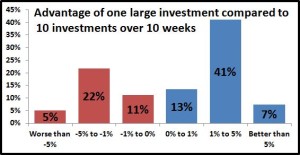When you start investing, one of the first decisions that you’ll need to make early on is what should you invest in, individual stocks or mutual funds. Let’s break it down, Dr Jack-style*.
ACCESSIBILITY: There was a time when “where” you could invest in either stocks or mutual funds was a big deal. For stocks you had to go to a broker like E-trade or TD Waterhouse. For mutual funds you typically worked directly with the mutual fund company like Vanguard or Fidelity. Now days pretty much all the companies have made it so you can invest in any mutual fund you want as well as have a brokerage account to buy individual stocks. Advantage: Push
COSTS: A bit of an interesting question. Over the years trading fees have really come down. Now days you can pretty easily find a firm that will charge $5 per trade or even less (Vanguard charges me $2). Compare that to mutual fund management fees which can range from 0.1% for index funds to 1.5% on the high end. As an example, if you have a nestegg of $500,000 and you’re paying 1% in mutual fund management fees, that’s $5000 each year. That would buy you 1000 trades at $5 each; unless you’re a day-trader, you’re probably not trading anywhere near that amount. Advantage: Stocks
DIVERSIFICATION: The major advantage of mutual funds is the diversification they give you in an easy package. Statistics show that an investor can be fully diversified with 20 or 30 different stocks, but you have to be pretty strategic in picking those, and that means a lot of work. Advantage: Big advantage to mutual funds
EFFORT NEEDED: Mutual funds just seem easier. You pick the one you want and invest in it. There are also features like automatic investment which allows you to set it up over time. With stocks, you have to make every purchase, and if you’re diversifying you have to make several purchases. That just seems like more work than is necessary. Advantage: Mutual funds
INTERNATIONAL INVESTING: I’m not an expert here, but I don’t know if you can invest in foreign stocks easily from your domestic brokerage. There are ADRs (American Depositary Receipts) which is another option to invest in foreign stocks, but all that starts to get a little confusing. International mutual funds are as easy to buy as domestic mutual funds, and you don’t have to go through any of the hoops. Advantage: Mutual funds
KNOW WHAT YOU HAVE: One problem with mutual funds is knowing what you actually own. Do you own Coca-Cola stock or not? Legally, mutual funds have to disclose this to some degree, but that’s a bit of a pain and depending on the type of mutual fund it might be constantly changing. With stocks you know exactly what you have at any given time because you own the actual stock. Advantage: Stocks
PICK WHAT YOU WANT: Some people are particular about the stocks they own for reasons beyond getting a good return. You had a terrible experience with AT&T so you won’t own their stock. You have moral issues with Wal-mart’s wage policies or Exxon’s environmental record. With mutual funds you’re a bit at the whim of the mutual fund manager, so it could very well mean you end up owning these stocks, and you may not even know it. This isn’t the case if you buy individual stocks because you know exactly what you’re buying and if you don’t like it or you do like it, you can act accordingly. Advantage: Stocks
BOND INVESTING: This is about stocks, but bonds present a special problem. If you buy bonds directly, they tend to come in large denominations like $1000 or $10,000. If you want to invest less than that in a given transaction, it’s not very easy unless you do it with mutual funds which allow you to invest in pretty much any denomination you want. Advantage: Mutual funds
DIVIDENDS: Many stocks (and nearly all bonds) pay dividends . The question is what to do with them? With stocks (and bonds) you typically get the cash deposited in your account, and then you need to figure out where to invest that. You have that option with mutual funds, but a nice advantage with most mutual funds is you can automatically invest it into the mutual fund. Advantage: Mutual funds
For me, mutual funds are the clear winner. I love how they make it really easy to invest and then move on. That’s the deciding factor for me. There certainly are disadvantages, but they aren’t that big a deal to me. I’m not really that particular about which stocks I own from a moral perspective. Costs are certainly important and that’s why I try to find the mutual funds with the lowest expenses by going with index mutual funds.
Actually the only stock I own is Medtronic stock that I get from my company’s stock purchase plan. Whenever I have the choice, I always go with mutual funds and never with individual stocks.
What do you think? Did I get this right, or do you think I missed something?
* Jack Ramsay was a coach in the Hall of Fame NBA, and he actually had a PhD from University of Pennsylvania (I guess that’s a decent school). He was famous for breaking down match up of teams with different criteria like defense, rebounding, speed, etc.




